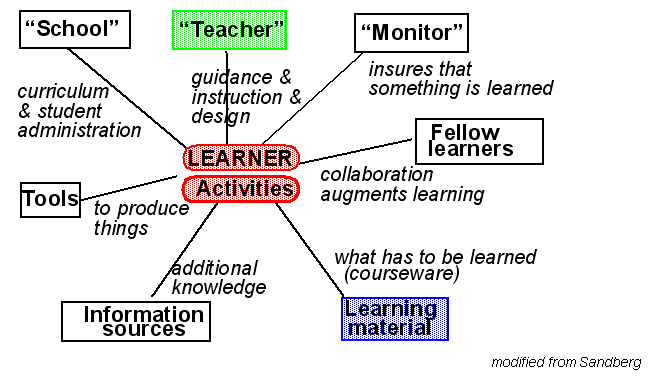Learning environment: Difference between revisions
Jump to navigation
Jump to search
| Line 3: | Line 3: | ||
* Conceptually speaking, the Learning Environment refers to the whole range of components and activities within which learning happens. | * Conceptually speaking, the Learning Environment refers to the whole range of components and activities within which learning happens. | ||
* Technically speaking, a Learning Environment is a Computer System such as a [[Learning management system]] | * Technically speaking, a Learning Environment is a Computer System such as a [[Learning management system]], a combination of [[:Category:Educational technologies | various educational technologies]] (including at least one communication module), [[virtual environment]]s, ... | ||
== Functions of a Learning Environment == | == Functions of a Learning Environment == | ||
Revision as of 16:37, 6 April 2006
Definition
- Conceptually speaking, the Learning Environment refers to the whole range of components and activities within which learning happens.
- Technically speaking, a Learning Environment is a Computer System such as a Learning management system, a combination of various educational technologies (including at least one communication module), virtual environments, ...
Functions of a Learning Environment
Sandberg's definition
(adapted by DSchneider)
- ``Teacher component: Its role is to provide something between loose guidance and direct instruction. It can be a human agent (present or distant), an intelligent agent, instructions like some text books provide, etc. This component provides information from the syllabus to the task level.
- ``Monitor component: Ensures that something is learned. A role taken by either the human teacher, the learner (self-control) or by some program.
- ``Fellow learners component: Improves the learning process (some research tries to implement artificial ones).
- ``Learning material, often Courseware: Contains what has to be learned in a very broad sense (knowing what, knowing how). It can be computational in various ways (exploratory hypertext, lesson and task oriented hypertext, simulation software, task solving environments, etc.).
- ``External information sources: All kinds of information which is not directly stored in the learning material (e.g. additional material, handbooks, manuals, etc.).
- ``Tools: Everything which may help the learning process other then the learning material (e.g. calculators, communication software, etc.)
- ``School [a category we added]: Something that provides a curriculum and does student administration.
References
Sandberg, J. A. (1994). Educational paradigms: issues and trends. In Lewis, R. Mendelsohn, P., (ed.), Lessons from Learning, (IFIP TC3/WG3.3 Working Conference 1993), pages 13--22, Amsterdam. North-Holland.
